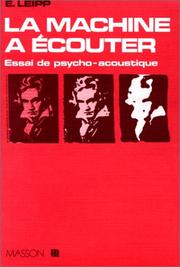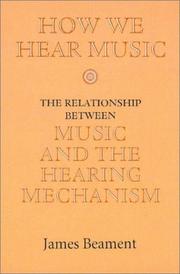| Listing 1 - 4 of 4 |
Sort by
|
Book
ISBN: 9171002642 Year: 1984 Publisher: Stockholm Nationalmuseum
Abstract | Keywords | Export | Availability | Bookmark
 Loading...
Loading...Choose an application
- Reference Manager
- EndNote
- RefWorks (Direct export to RefWorks)

ISBN: 2225458375 9782225458378 Year: 1977 Publisher: Paris : Masson,
Abstract | Keywords | Export | Availability | Bookmark
 Loading...
Loading...Choose an application
- Reference Manager
- EndNote
- RefWorks (Direct export to RefWorks)
Auditory perception. --- Hearing --- Sound --- Perception auditive --- Audition (Physiologie) --- Son --- Experiments --- Psychological aspects --- Expériences --- Aspect psychologique --- Auditory perception --- Testing --- -Hearing --- -Acoustics --- Audition (Physiology) --- Physiological acoustics --- Bioacoustics --- Senses and sensation --- Audiology --- Auditory pathways --- Deafness --- Ear --- Listening --- Sound perception --- Perception --- Word deafness --- -Experiments --- Expériences --- Acoustics --- Audiometer --- 78.82 --- Hearing - Experiments --- Hearing - Testing

ISBN: 0851159400 0851158137 9786611949037 1281949035 1846154413 9780851159409 Year: 2001 Publisher: Rochester, NY : Boydell Press,
Abstract | Keywords | Export | Availability | Bookmark
 Loading...
Loading...Choose an application
- Reference Manager
- EndNote
- RefWorks (Direct export to RefWorks)
Choice Outstanding Academic Title (2002)Our hearing system chose the sounds for music. During the past fifty years there have been spectacular advances in our knowledge of how that system works and it seems possible that it might provide explanations for a range of musical phenomena. This book begins by discussing the early evolution of simple 'western' tonal music; what exactly were the characteristics of the intervals and scales which hearing selected. It then considers problems such as what hearing has selected as instrumental tone, and why we have such a peculiar assessment of loudness; why is that independent of pitch, and why is hearing so sensitive to time? Does the mechanism of hearing determine our pitch discrimination, which differs so much across our hearing range? Amongst other things, this discussion leads to the conclusion that the harmonics of musical sounds, which are the basis of so much theory about music, did not and cannot play the role which has been so widely attributed to them ever since the work of Helmholtz in 1870. There follows a simplified account of the hearing mechanism: how musical sound is coded by the ear, the nature of the processing stations through which the information passes before it creates sensation in the cortex, and the extent to which it provides answers to the questions which have been raised. This produces a rather different view of the basis of some fundamental features of music from those which are commonly held. It also leads to the conclusion that music started with primitive instruments rather than with the human voice. Finally, the biological reasons for the hearing mechanism behaving as it does are explained, and thus the reasons for the sensations of music being experienced in the way they are. No scientific knowledge is assumed; any simple physical acoustics required is explained, and there are no mathematical equations. The late Professor Sir JAMES BEAMENT was a distinguished scientist and musician, who taught and examined music students at Cambridge University.
Acoustics --- Acoustique --- Akoestiek --- Audition (Physiology) --- Gehoor --- Hearing --- Music -- Perception --- Musical perception --- Musique -- Perception --- Muziek -- Perceptie --- Muzikale perceptie --- Muzikale waarneming --- Oreille absolue --- Oreille musicale --- Ouïe --- Perception de la musique --- Perception musicale --- Physiological acoustics --- Music --- Acoustics and physics --- Music - Acoustics and physics. --- Music - Acoustics and physics --- Music - Physiological aspects --- Musical perception. --- Hearing. --- Acoustics and physics. --- Ouïe --- Musique --- Acoustique et physique --- 515 --- 840 --- Musical acoustics --- Physics --- Sound --- Monochord --- Auditory perception --- Bioacoustics --- Senses and sensation --- Audiology --- Auditory pathways --- Deafness --- Ear --- Listening --- Akoestika --- Muziekgeschiedenis: essays (histor. onderwerpen, literaire analyses) --- Psychological aspects --- 78.82 --- Acoustics. --- Hearing Mechanism. --- Music. --- Sound Direction. --- Western Music.
Book
ISBN: 2919878085 9782919878086 Year: 1998 Publisher: Luxembourg Musée d'histoire de la Ville de Luxembourg
Abstract | Keywords | Export | Availability | Bookmark
 Loading...
Loading...Choose an application
- Reference Manager
- EndNote
- RefWorks (Direct export to RefWorks)
Catalogus van de gelijknamige tentoonstelling die doorging in Villa Vauban, het kunstmuseum van de stad Luxembourg. We maken kennis met de manier waarop de vijf zinnen (smaken, ruiken, zien, horen en voelen) afgebeeld worden in de kunsten. De getoonde werken blijven beperkt tot twee dimensies: geen installaties of sculpturen, alleen prenten en schilderijen.
Middle Ages. --- Musée d'histoire et d'art (Luxembourg) --- Luxembourg (Luxembourg) --- Metz (France) --- Trier (Germany) --- History. --- Middle Ages --- Dark Ages --- History, Medieval --- Medieval history --- Medieval period --- World history, Medieval --- World history --- Civilization, Medieval --- Medievalism --- Renaissance --- History --- Musée d'histoire et d'art (Luxembourg) --- Luxemburg (City). --- Museum of Luxembourg --- Musée d'histoire (Luxembourg) --- Luxembourg. --- Musée de Luxembourg --- Musées de l'Etat (Luxembourg). --- State Museum of History and Art (Luxembourg) --- Musée d'histoire de la ville de Luxembourg --- Musée de l'Etat d'histoire et d'art (Luxembourg) --- Musée national d'histoire et d'art (Luxembourg) --- Treves (Germany) --- Trier, Ger. --- Augusta Treverorum (Germany) --- Augusta in Treveris (Germany) --- Augusta Trevirorum (Germany) --- Colonia Treverorum (Germany) --- Trevereca Urbs (Germany) --- Treverensium Civitas (Germany) --- Treverica Urbs (Germany) --- Treveris (Germany) --- Treverorum Civitas (Germany) --- Treviri Civitas (Germany) --- Treviris (Germany) --- Trevirorum Civitas (Germany) --- Trevirum (Germany) --- Tueri (Germany) --- Senses and sensation in art --- Painting, European --- Prints, European --- Iconography --- Painting --- senses --- iconography --- easel paintings [paintings by form]
| Listing 1 - 4 of 4 |
Sort by
|

 Search
Search Feedback
Feedback About
About Help
Help News
News